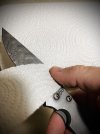- Joined
- Sep 24, 2020
- Messages
- 790
The weekly mailer (newsprint), receipt paper and magazine paper are a good gauge for me. I normally will do draw and push cuts on each. Push cuts especially can normally be a good indicator of the sharpness - or at least for what I care about.
The sound is key as well, I like to really listen to the cut; I can typically hear if something is hanging up or if I need to work on an area on the blade.
The sound is key as well, I like to really listen to the cut; I can typically hear if something is hanging up or if I need to work on an area on the blade.

